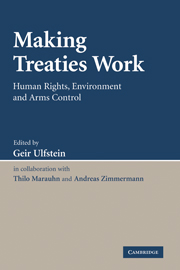Book contents
- Frontmatter
- Contents
- Preface and acknowledgments
- Notes on the contributors
- Table of cases
- Table of treaties and other international instruments
- INTRODUCTION
- PART I INTERNATIONAL HUMAN RIGHTS
- PART II INTERNATIONAL ENVIRONMENTAL LAW
- 5 Dispute resolution, compliance control and enforcement in international environmental law
- 6 The Convention on International Trade in Endangered Species of Wild Fauna and Flora (CITES)
- 7 The Convention on Long-Range Transboundary Air Pollution
- 8 The Convention on Access to Information, Public Participation in Decision-Making and Access to Justice in Environmental Matters (Aarhus Convention)
- 9 The Convention on Environmental Impact Assessment in a Transboundary Context (Espoo Convention)
- PART III INTERNATIONAL ARMS CONTROL
- GENERAL COMMENTS
- Index
7 - The Convention on Long-Range Transboundary Air Pollution
Published online by Cambridge University Press: 05 September 2009
- Frontmatter
- Contents
- Preface and acknowledgments
- Notes on the contributors
- Table of cases
- Table of treaties and other international instruments
- INTRODUCTION
- PART I INTERNATIONAL HUMAN RIGHTS
- PART II INTERNATIONAL ENVIRONMENTAL LAW
- 5 Dispute resolution, compliance control and enforcement in international environmental law
- 6 The Convention on International Trade in Endangered Species of Wild Fauna and Flora (CITES)
- 7 The Convention on Long-Range Transboundary Air Pollution
- 8 The Convention on Access to Information, Public Participation in Decision-Making and Access to Justice in Environmental Matters (Aarhus Convention)
- 9 The Convention on Environmental Impact Assessment in a Transboundary Context (Espoo Convention)
- PART III INTERNATIONAL ARMS CONTROL
- GENERAL COMMENTS
- Index
Summary
General
In the late 1960s and the 1970s, scientists demonstrated the interrelationship between the long-range transport of air pollutants and the acidification of lakes and forest death in Scandinavia, Central Europe and North America. To describe this phenomenon, the concept of transboundary air pollution was introduced to underscore the fact that air pollutants do not respect national boundaries, and that there was a need for international action.
Intensive diplomatic activities finally led, in 1979, to the conclusion of the Convention on Long-Range Transboundary Air Pollution (the ‘LRTAP Convention’) under the auspices of the United Nations Economic Commission for Europe. The Convention was concluded by almost all countries of Western and Eastern Europe and by the United States and Canada. Currently, there are forty-nine parties to the Convention.
The Convention includes general provisions on policies and strategies, research, exchange of information and institutional setting. In order to monitor the deposition and concentration of air pollutants, the Convention integrated the EMEP monitoring programme (‘Co-operative Programme for the Monitoring and Evaluation of the Long-Range Transmission of Air Pollutants in Europe’) into its framework. Furthermore, the Convention contains provisions that the Executive Secretary of the United Nations Economic Commission for Europe serves as the Secretariat of the Convention.
The Convention does not include specific reduction limits or control measures, but rather provides a framework within which the contracting parties can agree on specific regulations. To this end, the Executive Body was established to serve as the supreme body of the Convention.
- Type
- Chapter
- Information
- Making Treaties WorkHuman Rights, Environment and Arms Control, pp. 161 - 178Publisher: Cambridge University PressPrint publication year: 2007
- 1
- Cited by

